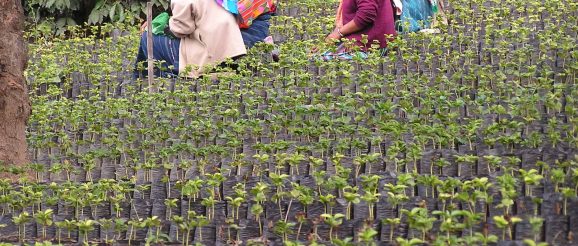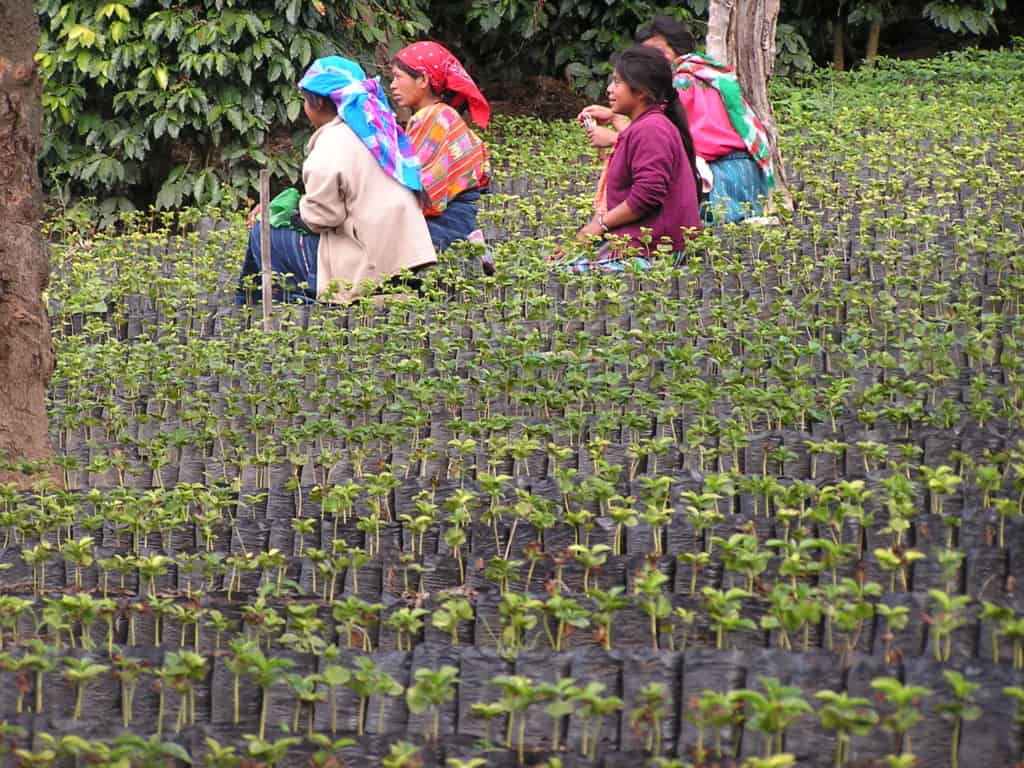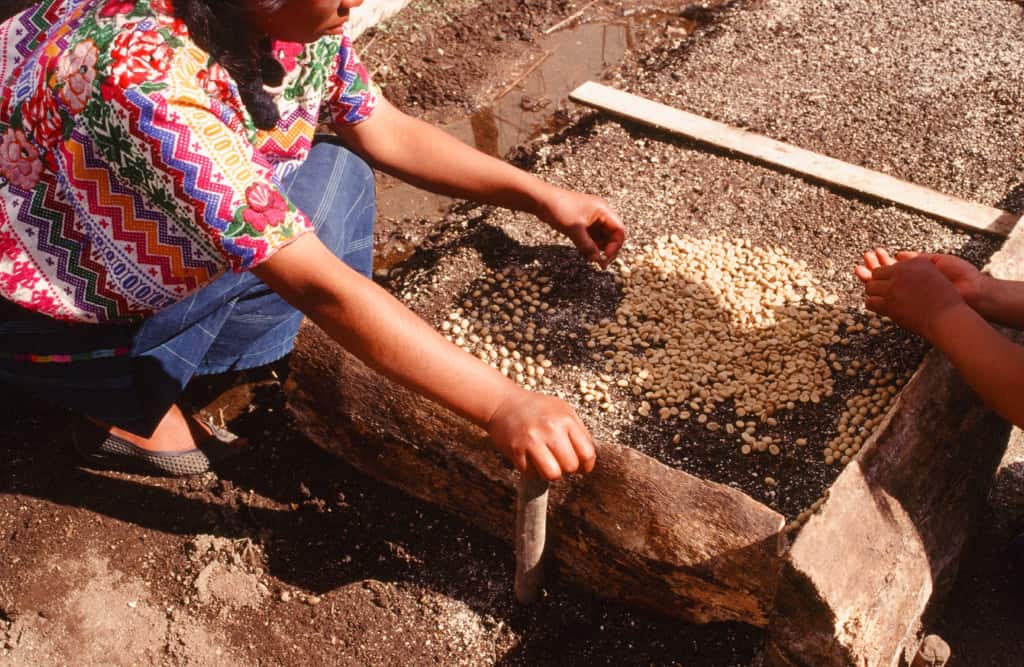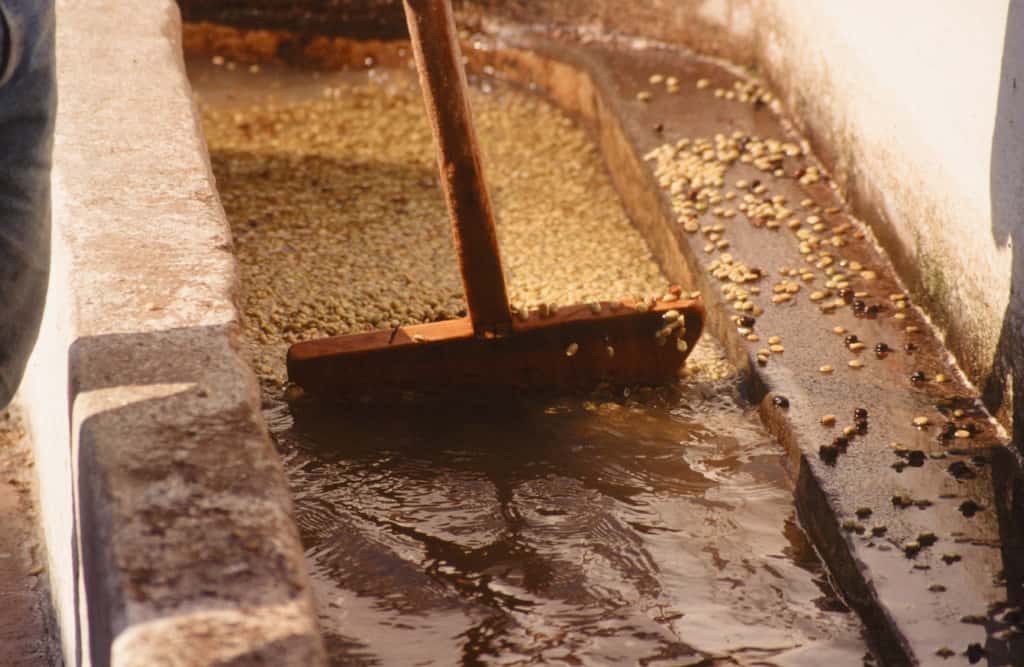Tradition, Diversity & Measured Innovation Elevate Guatemala Coffees


Women taking a break while working in a coffee nursery on a Guatemalan farm. Courtesy of Kenneth Davids.
While some people in the specialty coffee industry still refer to the “classic Central America cup,” effectively lumping together the diverse coffee-producing countries of Guatemala, Honduras, Nicaragua, El Salvador and Costa Rica, it is more the trend now to make increasingly fine distinctions among these origins in terms of varieties, processing, and cup profiles specific to each. Single-origin coffees are the primary driver of sales in the specialty market, and this month, we look at the coffees of Guatemala, something we haven’t done in report format since 2013.
When Coffee Review editor Kenneth Davids surveyed the landscape of Guatemala coffees more than 20 years ago, the themes that emerged were growing region, roast level, and the efforts of Anacafe, the Guatemalan Coffee Association founded in 1960, to frame the country as a worthy and distinct competitor in the specialty coffee arena after decades of civil war. In 1990, “Guatemalan Coffees” was launched as the branded name of an increasing specialty coffee output, and in 2018, coffee was recognized by the Guatemalan government as an “Intangible Heritage of the Nation” for its contribution to the national economy and its historical rootedness in the culture.
By the time we published our 2013 Guatemala report, producers were starting to experiment with planting different coffee varieties, but we didn’t see the processing experiments that were already well underway in nearby Costa Rica. Perhaps battles with leaf rust slowed down the experimental spirit, but it may just be that classic washed coffees represented the Guatemala name well enough to satisfy both producers and consumers.
How are things in 2021? In one sense, the story of coffee in Guatemala is like the story of specialty coffee across the globe: Coffee drinkers, importers and roasters are busy looking for the next great novelty. This impulse is part human nature, part the privilege of easy access to coffees from almost anywhere. For coffee producers at origin, scratching that itch by offering unusual varieties or experimental processing methods can result in higher premiums. But what was interesting about cupping the 52 coffees we received for this report is that traditional varieties and processing methods still seem to rule the Guatemala roost, at least if we judge in terms of ratings.

Planting seeds in a Guatemalan coffee nursery. Courtesy of Kenneth Davids.
Of the 52 coffees we received for consideration, 33 were washed-process, 15 were natural-processed, two were honey-processed, and two were processed anaerobically. The highest-scoring ten, which we review here at 92 to 96, are mainly traditional washed-process, with two naturals.
In terms of varieties of Arabica among the submissions, if we consider the traditional varieties grown in Guatemala to be Bourbon, Caturra, Catuaí, Typica, Maragogype, Pache and Pacamara, then the only outliers we review here are two Geishas, both washed. Since its rediscovery in 2004 the Geisha variety has been carried into every coffee growing region in the world, or so it seems, prized for its rich florality, focused fruit, and balanced structure. But it’s the traditional varieties that dominate this month’s reviews and ratings.
Two Standout Washed Geishas Roasted in Taiwan
GK Coffee’s Sierra Roja Geisha, which rated 96, is a Geisha in technicolor — focused and confident with exuberant florals throughout the cup — and it’s woman-farmed. Lorena Castillo Castellanos of Sierra Roja Farm, in the cloud forest of Sierra de las Minas, began farming her father’s shade-grown trees two years ago. Castellanos has a background in conservation and sustainability, values she brings to Sierra Roja as she experiments with new varieties and processing methods.
For GK roaster Gary Liao, Guatemala is the epitome of a classic producing region because the coffees it produces represent a range of sensory expression, which helps him perfect his own sensory training in identifying specific coffee varieties. Geishas from the highlands, he says, are unmistakable for their rich floral sweetness and high-toned acidity. (He likes this Sierra Roja as cold-brew, as well as filter coffee.)
Another Taiwanese roaster, woman-owned Green Stone Coffee, submitted a lovely washed Geisha that’s also from the high-altitude, Geisha-friendly Sierra de las Minas region. This coffee, which scored 93, is intensely fruit-driven with notes of passion fruit and spicy florals.
Of this coffee, Green Stone owner and educator Kelly Wang says she likes the bright, balanced acidity that high-grown Geishas can offer. She particularly admires fourth-generation farmer Teodoro Engelhardt’s vision to create a farm representing a self-sustainable ecosystem in the micro-climate of a tropical rainforest.
The Many Faces of Classic Washed Varieties
The heart of our own experience cupping through more than 50 Guatemala coffees from all over the country resided particularly in the success of classic varieties processed by the traditional washed method. What’s interesting is that the top six washed, non-Geisha samples we review here, ranging from 92-94 in score, were grown in four different regions: Huehuetenango (in the northwest highlands), Fraijanes (a south-central plateau), Lake Atitlan (in the southwest), and Lake Amatitlán (south of Antigua). And almost all of the traditional varieties are represented here; only Maragogype is missing.

Freshly released from the fermentation tank, coffee beans at a traditional Guatemalan mill are “washed” or cleaned of fruit residue in a channel of moving water. Courtesy of Kenneth Davids.
Of these classic coffees, San Diego’s Nostalgia Coffee Roasters’ Guatemala La Voz earned the top score at 94. Owner-roaster Taylor Fields says this coffee was originally selected for Nostalgia’s Memory Lane blend, but the team loved it so much that they decided to offer it as a single-origin selection. Comprised of Typica, Bourbon and Caturra, the cup profile displays both deep chocolate and high-toned citrus notes. Grown near the shores of famous Lake Atitlan, this coffee is produced by smallholding members of La Voz que Clama en el Desierto cooperative, whose production is highly regarded throughout the country for its clarity and brightness.
Iconic farm El Injerto is known for its early adoption of a policy of not supplementing its own production by buying coffee in parchment from other farms. This policy created what is essentially an “estate” coffee, much like an estate wine, with the Aguirre family controlling every step, from planting to milling and every other stage along the way. Women-owned Equator Coffee, based in San Rafael, California, sent us El Injerto’s washed Pacamara (93), a beautiful example of this inherently sweet savory variety, richly bittersweet (think hop flowers) and deeply chocolaty with a full, viscous body. El Injerto is located in what is perhaps Guatemala’s most famous growing region, Huehuetenango, on the slopes of the central mountain range, where soils are mostly clay and altitudes range from 3,000-6,000 feet, allowing for a broad range of expression.
Equator’s Director of Coffee Ted Stachura says, “The Aguirre family has a laser-focused approach to new varieties and processing methods. Once experimentation is complete, the resulting coffee they are able to produce is of the highest quality. If the results of their testing doesn’t show great potential, they do not bother offering those types. Pacamara has a proven track record on the farm and we are now purchasing a small quantity of this coffee every year.”
Another Huehuetenango coffee, a Pache grown in Santa Barbara, was submitted by States Coffee (93). Owner Keith Gehrke says of Guatemala coffees, in general: “I really fell in love with coffee from Guatemala back in 2007 when I met Edwin Martinez from Finca Vista Hermosa. His coffee was amazing, and he became a friend. That was also the first time I was a head roaster for a company. So, a very memorable and nostalgic experience for me now. Guatemala coffees have such a great balance in the cup, along with body and sweetness, so that if I had to choose only one origin to buy forever, I would probably pick Guatemala.” This Pache exemplifies Gehrke’s observation with its vibrantly sweet, subtly complex profile. Pache is a natural dwarf mutation of Typica, discovered in Guatemala in 1949.
Finally, Denver-based Novo Coffee Roasters submitted an El Mirador (93), also from Huehuetenango. This blend of Caturra, Catuai and Bourbon grown by smallholding farmers is crisply chocolaty with undertones of sweet herbs.
One entry from the Fraijanes Plateau, a region that began exporting in earnest to the U.S. only in the last two decades, comes from Kakalove Café in Chia-Yi, Taiwan. It’s thought that because much of the soil in this area is volcanic, coffees grown in Fraijanes exhibit distinctively balanced acidity, which is certainly true of this coffee, a Yellow Catuaí (93). Owner-roaster Caesar Tu says that Oscar Pimentel’s farm is mostly experimental microlots, but because of shipping delays related to Covid-19, his selection for importing to Taiwan was quite limited, so he felt lucky to find this sweet, vibrant, resonant cup, the epitome of a daily-drinker.
Charlotte, North Carolina’s Magnolia Coffee offers this Guatemala Finca San Gerardo. Courtesy of Magnolia Coffee.
Rounding out the best of the classic submissions is Charlotte, North Carolina-based Magnolia Coffee’s Finca San Gerardo Bourbon (92), a deep-toned floral and nutty cup grown in the Lake Amatitlán region of south-central Guatemala, just south of Guatemala City (and not to be confused with the larger Lake Atitlan). Owner Jay Gestwicki has been buying green coffee from this farm for a number of years. He says he was looking for “an exceptional everyday drinking coffee” with clear chocolate notes and lots of nuance, and this coffee fits the bill.
Two Compelling Natural-Processed Coffees
The number of natural-processed coffees we review at Coffee Review has steadily increased, year by year. In the context of Central America, Guatemala may be far less exuberant in experiment than Costa Rica, El Salvador and certainly Panama in terms of getting on the “funky train” of anaerobic processing, but naturals — coffees that have been dried in the whole fruit — appear to be coming on strong. Of the 15 natural-processed coffees we received for this report, two scored 92, which we review here: Taiwan-based Qin Mi Coffee’s Acatenango Pacamara Natural and Plat Coffee’s Finca Granada Natural.
The former represents yet another growing region, Acatenango, whose sandy soils are enriched by minerals from regular volcano eruptions nearby, perhaps encouraging coffees that display savory tones as well as sweet. Qin Mi’s Pacamara is cleanly fruity and richly bittersweet. The Plat Finca Granada is a Bourbon-Caturra blend from Huehuetenango with notes of pie cherry, lavender, and cocoa nib. Plat’s Raymond Cheung likes Guatemala naturals for the value they offer, while Qin Mi’s roaster “Hank” chose this particular natural from 40 Guatemalas he blind-cupped.
Qin Mi’s roaster “Hank” chose an Acatenango Pacamara natural from 40 Guatemala coffees he blind-cupped. Courtesy of Qin Mi Coffee.
Balance, Familiarity, Quality
The biggest takeaway from our cupping is that Guatemala is a go-to origin for balanced coffees of a style we recognize and love, whose quality is high across the board, and whose innovation is measured and largely successful.
The post Tradition, Diversity & Measured Innovation Elevate Guatemala Coffees appeared first on Coffee Review.
